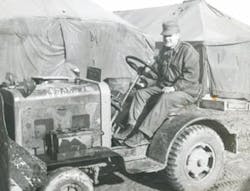The 'AGE' of Serendipity
While visiting a friend of mine in Portland, Oregon in June, I had the pleasure of meeting her retired parents who were staying with her for the month. Her Dad, George, is a soft-spoken man with a thick Boston accent and few words … perhaps because his wife, Stephanie, had plenty to say … and what a hoot taboot! In less than an hour's time I knew her entire life's story.
These conversational dynamics quickly took a 180 degree turn when George discovered I edit a magazine titled "Ground Support Worldwide" with a supplemental military e-Issue. He had been in the Air Force for eight years as an AGE Ranger in the 1950's and wanted to hear all about the magazine. I was eager to hear all about his experience in the Air Force and his time in Korea.
A Wrench Is My Choice
George was an automobile mechanic working in his hometown of Gloucester, Massachusetts when he joined the Air Force. Given his experience, he was able to take a bypass test for mechanics, eliminating any Air Force schooling. After basic training he went to Selma, Alabama, where he was in the motor pool responsible for the mechanical upkeep and repairs on all of the vehicles - buses, trucks, fire equipment, pick-ups … basically anything else with wheels on the Air Force base.
In July of 1953, George received his orders to be stationed in Korea with the 16th Fighter Interceptor Squadron, one of three squadrons in the 51st Fighter Wing. The war had just ended. The troops at the base known as K-13 in Suwon, Korea were still carrying weapons. In fact, the unit he came over with also carried weapons when they first arrived but as George puts it, "That changed very quickly after one of our guys shot himself in the foot. They took the weapons away from us!"
Ground Power, Today and Yesterday
A team of three, which included George, his staff sergeant and one other, worked out of a tent on the tires of F-86 "checkertail" Saber Jets. The checkertails first appeared in the Korean War in July 1952 on the 51st aircraft. George explained that the papasans (a term of endearment for the Koreans who assisted on the base) were the people who would actually change the tires on the aircraft.
Though the war had ended, the fighter squadrons were flying constantly on short missions because the North Koreans were still in the hills surrounding the bases. "Everytime the aircraft lands it scrubs off the rubber," says George, "so the tires had to be changed often."
The squadron also took care of all the APUs, hydraulic equipment that they would transport wherever it was needed and keeping every piece of equipment fueled. George proudly stated, "It was called Ground Power then." To which I replied, "Though much has changed since you have been in George, that's one thing that hasn't changed, it's still called Ground Power today. And as we both know, there is no Air Power without Ground Power."
George recalled an incident where his squadron was told that a plane had to make an emergency landing on an island off the North Korean coast where the U.S. military had supposedly gained control. "They told us we were going to have to take an APU up there with a Gooney Bird, the nickname for a C-47 in the air force and we were going to have to try to get that plane airborne again," says George. As a military aircraft, the C-47 Gooney Bird was used for supplies to airfields and, most importantly, dropping paratroops for taking over neutral airfields. A slow climber, it was considered easy pickings to blow the Gooney Bird with a single hit. It was never intended to fulfill a high altitude role, and thus is limited to 25,000 feet or below.
"I was relieved when we learned that somebody else at another base did it," says George.
It's in the Blood
George was in Korea for a year. After he completed his term in the Air Force, he went to school at Franklin Technical Institute in Boston for automotive. For a short period of time he worked at Dayton Air Force Base as a technical representative in ground power, but the technology had changed from the APU that had a gas engine to a jet engine, which he realized he knew nothing about. George returned home to Gloucester with his wife, opened his own shop, raised four children and is now retired … happily recounting memories gone by on this serendipitous exchange that we shared.
If you have a story about yourself or a relative in AGE, please contact me at so we can share it with our readers.
As always, thank for reading.
Karen Reinhardt
